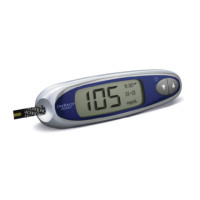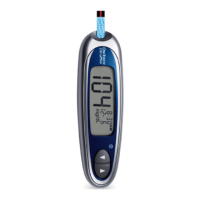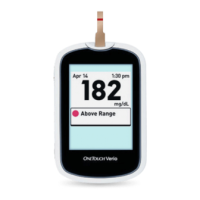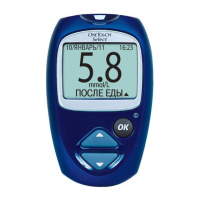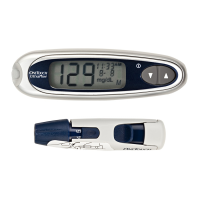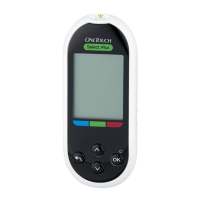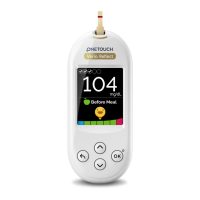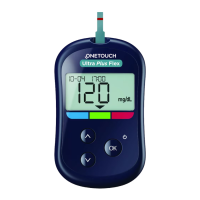27
ERROR MESSAGES AND DETAILS ABOUT YOUR SYSTEM
Detailed information about your system
Comparing meter and laboratory results
Test results with the OneTouch® UltraEasy™ Meter are plasma-calibrated. This helps you and your health care professional to compare your
meter results with laboratory tests. If you have been using another type of meter—one that provides whole blood-calibrated results—you
may notice that your test results with the OneTouch® UltraEasy™ Meter are approximately 12% higher. OneTouch® UltraEasy™ Meter test
results and laboratory test results both are expressed in plasma-equivalent units. However, your meter result may dier from your laboratory
result due to normal variation. Meter results can be aected by factors and conditions that do not aect laboratory results in the same way.
Your OneTouch® UltraEasy™ Meter glucose value is considered accurate when it is within ±20% of the laboratory measurement. There are some
specic situations that could cause a dierence of more than ±20%:
• You have eaten recently. The blood glucose level from a nger stick can be up to 70 mg/dL higher than blood drawn from a vein (venous
sample) used for a lab test.
1
• Your hematocrit (percentage of blood that is red blood cells) is high (above 55%) or low (below 30%).
• You are suering from severe dehydration.
• You tested at a temperature near the low end of the operating range (6°C) and you get a high glucose result (i.e., greater than 180 mg/dL). In
this situation, repeat the test in a warmer environment with a new test strip as soon as possible.
For accuracy and precision data and for important information on limitations, see the insert that comes with your test strips. To maximize your
chances of an accurate comparison between meter and laboratory results, follow a few basic guidelines:
Before going to the lab
• Perform a control solution test to make sure the meter is
working properly.
• Do Not eat for at least eight hours before you test your blood.
• Take your meter with you to the lab.
While at the lab
• Conduct your meter test within 15 minutes of the lab test.
• Use only fresh, capillary blood obtained from the ngertip.
• Follow all instructions in this User Guide for performing a
blood glucose test with your meter.
1. Sacks, D.B.: “Carbohydrates.” Burtis, C.A., and Ashwood, E.R. (ed.), Tietz Textbook of Clinical Chemistry. Philadelphia: W.B. Saunders Company (1994), 959.
Technical specications
Reported result range 20–600 mg/dL
Calibration Plasma-equivalent
Sample Fresh capillary whole blood
Test time 5 seconds
Assay method Glucose oxidase biosensor
Meter power source One replaceable 3.0 Volt CR 2032
lithium battery (or equivalent)
Unit of measure mg/dL
Memory 500 blood glucose test results
Automatic shuto 2 minutes after last action
Size 10.8 x 3.20 x 1.70 cm
Weight Approximately 40 grams, with battery
Operating ranges
Temperature: 6–44°C
Altitude: up to 3048 meters
Relative humidity: 10–90%
Hematocrit: 30–55%
Battery ratings One 3.0 V d.c., 3 mA
(one CR 2032 battery)
direct current

